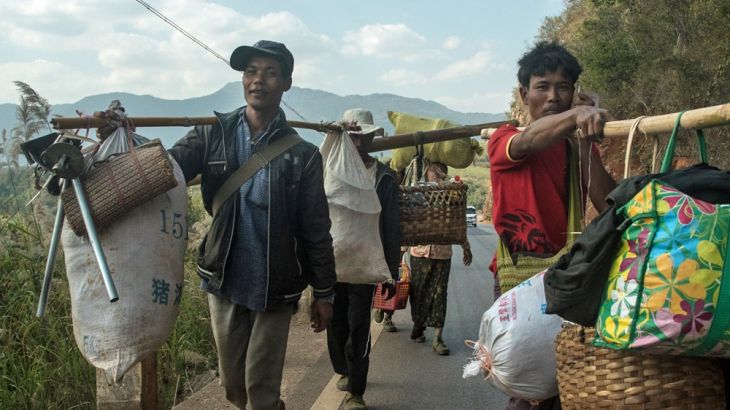China grapples with refugee influx from Myanmar
First-hand report from a border town now sheltering people fleeing the fighting in Kokang area of Myanmar’s Shan state.

It’s probably fair to say that this isolated corner of China is not used to unannounced visits by foreign reporters.
That was abundantly clear after we were detained for the third time in as many hours during our road journey to the unremarkable border town of Nansan.
This area of Yunnan province straddles the frontier with Myanmar and is notorious for people-smuggling and drug-trafficking.
The proceeds from the illegal drug trade are almost certainly helping fund the latest bout of fighting now raging across the border.
Our edgiest encounter was with the paramilitary police who now guard the biggest camp for refugees.
We wanted to show how China was dealing with the plight of so many refugees from Myanmar, who also happen to be ethnic Chinese.
I had just begun recording a camera statement when the men in uniforms began shouting and putting their hands over the lens.
Some were holding retractable cattle prods that appeared primed for action.
Within what seemed like seconds, more police began running towards us.
‘No photos please’
We were surrounded.
Identity cards and passports were demanded and handed over.
The refugees looked on bemused.
Over their baffled invective, we tried to explain that we were journalists with the correct credentials entitling to film anywhere in China, with the exception of Tibet.
![The tension that now exists between China and Myanmar is evident in the fallout from the fighting in Kokang [Al Jazeera/Miguel Toran]](/wp-content/uploads/2015/02/d3b75fc8b4c648b6a6b9d4e1925b6dd9_18.jpeg)
Even Chinese journalists are not a allowed to take pictures of this camp, we were told.
Eventually a plainclothed official arrived reeking of alcohol, no doubt the consequence of some enthusiastic celebration to mark the Chinese New Year.
Slurring his words and apparently cursing the foreigners who had disrupted his lunch, he showed us around the camp, which also happened to be Nansan’s new trade and exhibition centre.
But we were forbidden from talking to the refugees or taking any pictures.
The centre is a symbol of China’s economic hopes for the region. But as long as the fighting goes on, it will remain a temporary refugee camp.
On Saturday morning we returned to the centre. Many of the refugees were sitting outside enjoying the sun.
But when a soldier saw our camera, he barked at the refugees to go back inside. They meekly obliged.
The main border crossing between China and Myanmar was eerily quiet on Saturday.
Normally thriving with traders from both countries, the frontier remains closed, making it harder for those who want to flee the fighting.
Source of anxiety
You don’t choose your neighbours. And China has 14 of them.
But one is causing particular angst right now because Myanmar was once considered a good and loyal friend.
In recent years China was about the only ally Myanmar had.
But the old certainties began changing when country’s reclusive leaders began courting the US and the EU.
In order to get the sanctions they imposed lifted, Myanmar needs to agree a ceasefire with the various ethnic groups that continue to resist attempts to enter the fold.
The tension that now exists between China and Myanmar is evident in the fallout from the fighting now taking place inside the Kokang area of Shan state, an area notorious for drug-smuggling and people-trafficking.
The latest violence is between Myanmar’s army and a self-styled militia called the National Myanmar Democratic Alliance Army.
Like the refugees, the militia are all ethnic Chinese. They share the same ethnicity, culture and language as those on the Chinese side of the border.
Some of the refugees we spoke to said they hoped China’s government would provide military support to help their campaign for greater autonomy in Kokang.
This is why the refugee problem is so potentially tricky for China.
Beijing insists it does and will not interfere in the internal affairs of other countries. But the NMDAA’s 86-year-old leader, Phone Kya Shin, had been living in exile in China before he returned to Myanmar two weeks ago.
That’s the exact time that the fighting began.
Thud of artillery fire
The NMDAA was formerly a part of Burma’s Communist party, a Chinese-supported group that waged war on the Myanmar government until it fell apart in 1989.
Last week an editorial in China’s state controlled Global Times newspaper lambasted the idea that China should back the NMDAA in the same way Russia has been supporting separatist groups in Ukraine.
“There are no grounds for comparing Kokang to Crimea. Those who are stuck in such comparisons are either spouting nonsense, or having ulterior motives,” it said.
![Chinese paramilitary police now guard the biggest camp for Myanmar refugees in China's Yunnan province [Al Jazeera/Miguel Toran]](/wp-content/uploads/2015/02/bb8797d3be5a469e8cba3e10c25a9107_18.jpeg)
In Nansan you can often hear the distant thud of artillery fire.
Some of the fiercest fighting has been happening in and around the town of Laukkai, just a few kilometres inside Myanmar.
This was where a Red Cross Society convoy was hit by gunfire on Tuesday as it attempted to bring refugees to the border.
Both sides in the conflict accused each other of carrying out the attack.
Laukkai is clearly visible from the Chinese side.
On Friday a Chinese photographer, Wang Kang Yuan, managed to reach the town on foot. He told me that in one street he saw the bodies of 20 men and women.
As he was taking pictures, soldiers screamed at him to stop.
A gun was put on his head and his camera gear, identity papers and wallet snatched from him.
Given Wang is ethnic Chinese, so he was lucky to get away with his life.